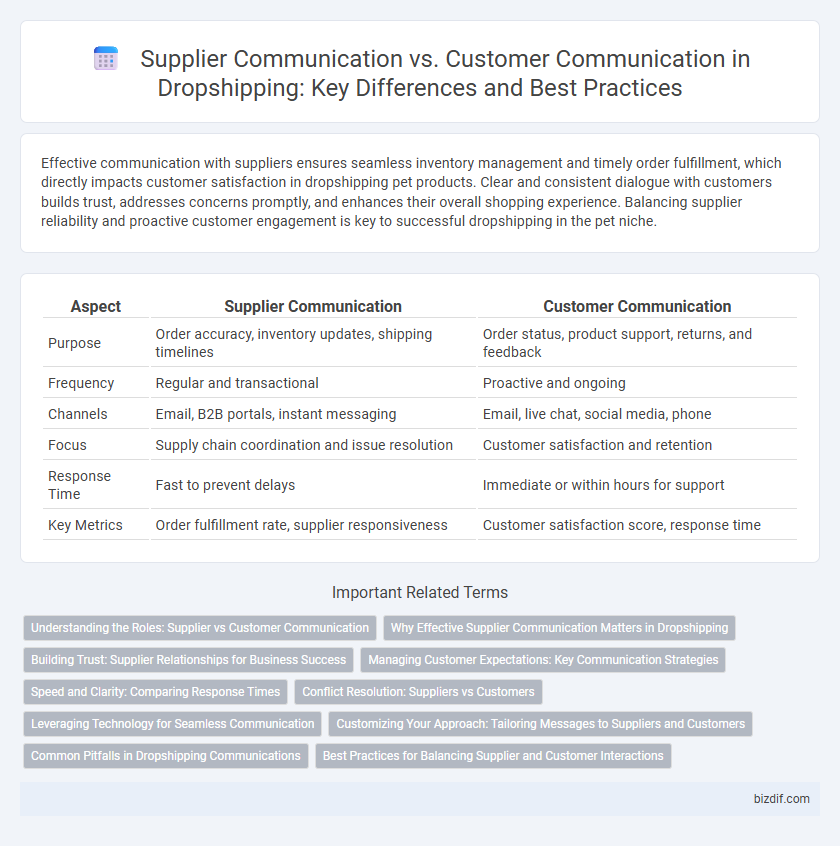Effective communication with suppliers ensures seamless inventory management and timely order fulfillment, which directly impacts customer satisfaction in dropshipping pet products. Clear and consistent dialogue with customers builds trust, addresses concerns promptly, and enhances their overall shopping experience. Balancing supplier reliability and proactive customer engagement is key to successful dropshipping in the pet niche.
Table of Comparison
| Aspect | Supplier Communication | Customer Communication |
|---|---|---|
| Purpose | Order accuracy, inventory updates, shipping timelines | Order status, product support, returns, and feedback |
| Frequency | Regular and transactional | Proactive and ongoing |
| Channels | Email, B2B portals, instant messaging | Email, live chat, social media, phone |
| Focus | Supply chain coordination and issue resolution | Customer satisfaction and retention |
| Response Time | Fast to prevent delays | Immediate or within hours for support |
| Key Metrics | Order fulfillment rate, supplier responsiveness | Customer satisfaction score, response time |
Understanding the Roles: Supplier vs Customer Communication
Supplier communication in dropshipping involves negotiating product availability, pricing, and shipping details to ensure timely order fulfillment. Customer communication centers on providing order updates, addressing inquiries, and managing returns to maintain satisfaction and trust. Understanding these distinct roles optimizes operational efficiency and enhances the overall customer experience.
Why Effective Supplier Communication Matters in Dropshipping
Effective supplier communication in dropshipping ensures timely inventory updates, accurate order fulfillment, and swift resolution of potential issues, directly impacting customer satisfaction. Clear and consistent interaction with suppliers minimizes errors, prevents stockouts, and maintains product quality standards, which are crucial for building trust and retaining customers. Optimizing supplier communication streamlines the entire supply chain, enabling faster delivery and enhancing the overall shopping experience in a competitive dropshipping market.
Building Trust: Supplier Relationships for Business Success
Effective supplier communication in dropshipping ensures timely inventory updates and order accuracy, which directly impacts customer satisfaction and trust. Transparent and consistent interactions with suppliers lead to reliable product quality and shipping times, building a strong foundation for customer confidence. Prioritizing supplier relationships enables seamless order fulfillment and enhances overall business credibility in the competitive e-commerce market.
Managing Customer Expectations: Key Communication Strategies
Effective supplier communication ensures real-time inventory updates and timely shipping, directly impacting customer satisfaction by preventing delays and stockouts. Transparent customer communication involves setting realistic delivery expectations and promptly addressing inquiries, which builds trust and reduces negative feedback. Implementing automated status notifications and clear return policies helps manage customer expectations, enhancing loyalty and repeat business.
Speed and Clarity: Comparing Response Times
Supplier communication in dropshipping demands rapid response times to ensure inventory accuracy and timely order fulfillment, often within hours to prevent stockouts. Customer communication prioritizes clear, concise updates typically delivered within 24 hours to maintain trust and reduce cancellation rates. Efficient use of automated messaging systems enhances speed and clarity in both channels, optimizing overall operational flow.
Conflict Resolution: Suppliers vs Customers
Effective conflict resolution in dropshipping requires distinct strategies for suppliers and customers. Supplier communication focuses on order accuracy, inventory issues, and timely shipping updates to prevent supply chain disruptions. Customer communication emphasizes transparent problem-solving, prompt responses, and clear refund or replacement policies to maintain trust and satisfaction.
Leveraging Technology for Seamless Communication
Leveraging technology in dropshipping enhances supplier communication through real-time inventory updates, automated order tracking, and instant messaging platforms that reduce errors and delays. Customer communication benefits from AI-driven chatbots, personalized email marketing, and omnichannel support, ensuring timely responses and improved satisfaction. Integrating CRM systems bridges the gap between suppliers and customers, creating seamless information flow and boosting operational efficiency.
Customizing Your Approach: Tailoring Messages to Suppliers and Customers
Effective dropshipping success depends on customizing communication strategies to meet the distinct needs of suppliers and customers. Supplier communication requires clear, precise messaging focused on inventory updates, order details, and product specifications to ensure smooth operations. Customer communication prioritizes personalized service, addressing inquiries, order tracking, and after-sales support to enhance satisfaction and trust.
Common Pitfalls in Dropshipping Communications
Ineffective supplier communication often results in inventory inaccuracies, delayed shipments, and order fulfillment errors, which directly impact customer satisfaction in dropshipping. Poor customer communication, such as lack of timely updates and unclear return policies, leads to negative reviews and increased refund requests. Establishing clear protocols and regular updates between suppliers and customers minimizes misunderstandings and streamlines the dropshipping process.
Best Practices for Balancing Supplier and Customer Interactions
Effective dropshipping relies on clear, consistent communication with suppliers to ensure accurate inventory updates and timely order fulfillment, minimizing disruptions and stockouts. Equally important is maintaining transparent customer communication by providing real-time order tracking, prompt responses to inquiries, and clear policies to build trust and reduce disputes. Balancing these interactions enhances operational efficiency and customer satisfaction, driving repeat business and positive reviews.
Supplier Communication vs Customer Communication Infographic

 bizdif.com
bizdif.com